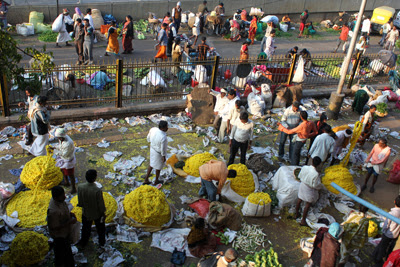Every marketplace in India is an aesthetic urban experience – whether
it’s a flower market, a wholesale tomato market or a temple bazaar. I
recollect and share here my experience of the flower market in
Bangalore. It is an informal market that takes place for two hours every
morning in the vicinity of the Krishna Rajendra market. The K.R. market
zone is one of the most chaotic, congested and noisy neighbourhoods in
the city of Bangalore. The city’s main intercity and local bus terminal
and the main railway station are located within a radius of a kilometre
from here. However, there is one time of the day when you would go there
even if you had no task or purpose in mind, in the early mornings, just
to enjoy the visual experience of the flower market.
The place where the market happens is not a street, it is not a square and it is not within a building. The market comes into being at an extremely busy traffic junction, a crossing of roads, a space just below a flyover. It is difficult to imagine this urban space as a flower market because it is not designed as a place for flowers and neither is it an organised traffic junction. It is simply a point in the city where the most number of cars, people and goods cross paths. This is where flower vendors gather every day and where business is brisk as retailers and individual customers buy flowers for consumption.
If one thinks about the edges of this urban space and of the flower market, one realises that it has no defined edges. The market stops where the last flower vendor sits. When there are no more flower vendors, there is no more flower market; until it appears again in a small lane much further away from the central location under the flyover. But, these small flower vendors in the small lanes continue to sell flowers throughout the day; whereas the main flower market opens at 5am and closes at 8am.
The place where the market happens is not a street, it is not a square and it is not within a building. The market comes into being at an extremely busy traffic junction, a crossing of roads, a space just below a flyover. It is difficult to imagine this urban space as a flower market because it is not designed as a place for flowers and neither is it an organised traffic junction. It is simply a point in the city where the most number of cars, people and goods cross paths. This is where flower vendors gather every day and where business is brisk as retailers and individual customers buy flowers for consumption.
If one thinks about the edges of this urban space and of the flower market, one realises that it has no defined edges. The market stops where the last flower vendor sits. When there are no more flower vendors, there is no more flower market; until it appears again in a small lane much further away from the central location under the flyover. But, these small flower vendors in the small lanes continue to sell flowers throughout the day; whereas the main flower market opens at 5am and closes at 8am.




